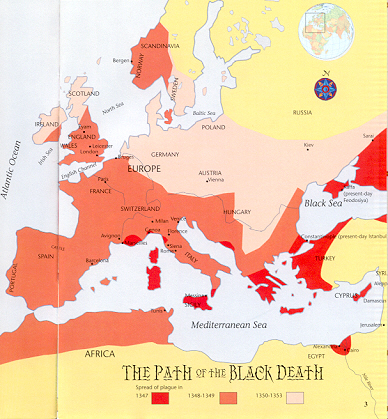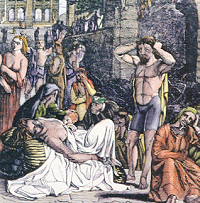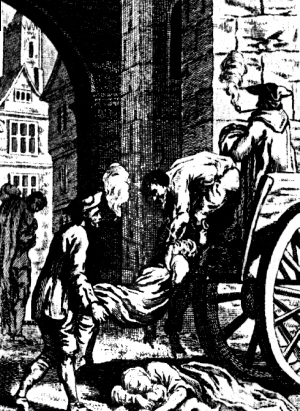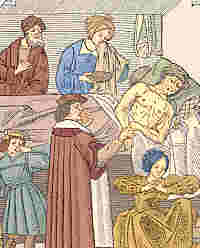


----------1347---1348-1349----1353

 before reaching the European continent where the initial outbreak occurred in
and around Italy. The disease struck and killed people with terrible speed.
In October, 1347 an eyewitness account claimed:
before reaching the European continent where the initial outbreak occurred in
and around Italy. The disease struck and killed people with terrible speed.
In October, 1347 an eyewitness account claimed:"Realizing what a deadly disaster had come to them, Italians were driven from their city. But the disease remained, and soon death was everywhere. Fathers abandoned their sick sons. Lawyers refused to come and make out wills for the dying. Friars and nuns were left to care for the sick, and monasteries and convents were soon deserted, as they were stricken, too. Bodies were left in empty houses, and there was no one to give them a Christian burial."
The "Black Death" was caused by the bacillus which was primarily an internal parasite of wild rodents, such as rats, mice and squirrels. It is carried to man by fleas deserting dying or dead animals in search of nourishment. It may enter the bloodstream directly as the flea bites the human or indirectly through contact between the fleas' excrement, and scratches or lesions on the the skin. (The Deadly Cycle)
When the bacteria invade the lymph nodes, the nodes swell and are called Buboes. Blood vessels break and cause internal bleeding. The dried blood under the skin turns black, hence the name "Black Death". (Gross Pictures) Symptoms include high fevers and aching limbs and vomiting of blood. The swellings continue to expand until they eventually burst, with death following soon after. The whole process from fever and aches to final expiration, is 3-4 days. The swiftness of the disease, the terrible pain, the grotesque appearance of the victims, all served to make the plague especially terrifying.
Another form of the disease was labeled as pneumonic plague so named because it was spread by infected droplets of the bacteria being inhaled from a sneeze of a stricken person.

 Little could be done to cure diseases because no one really knew what caused
them. Some people blamed the stars when they became ill. Some thought gluttony
or drunkeness was the cause. Some blamed England's cold, damp climate. During
the widespread outbreaks of the disease such as the plague, Jews were accused
of poisoning wells. It was not until the invention of the microscope in the
next century that scientists could see what caused the disease and how it was
spread. Doctors and city officials knew the plague was highly contagious, but
had no idea how it was spread. They knew the bodies of the dead should be avoided,
that their houses should be shut up, (or quarantined) and that garbage should
be burned. Their orders were mostly ignored. Elizabethan government was "insufficiently
organized to carry out with success an strict set of unpopular orders...the
authorities were forced to sit with folded hands until the plague had run its
course."
Little could be done to cure diseases because no one really knew what caused
them. Some people blamed the stars when they became ill. Some thought gluttony
or drunkeness was the cause. Some blamed England's cold, damp climate. During
the widespread outbreaks of the disease such as the plague, Jews were accused
of poisoning wells. It was not until the invention of the microscope in the
next century that scientists could see what caused the disease and how it was
spread. Doctors and city officials knew the plague was highly contagious, but
had no idea how it was spread. They knew the bodies of the dead should be avoided,
that their houses should be shut up, (or quarantined) and that garbage should
be burned. Their orders were mostly ignored. Elizabethan government was "insufficiently
organized to carry out with success an strict set of unpopular orders...the
authorities were forced to sit with folded hands until the plague had run its
course."
Additional measures taken by the city government were requiring the flushing of water into the streets after 8:00 P.M., shutting down theaters (1592-1594), and requiring the burning of any or all clothing belonging to the dead person. Hygiene, infection, and disease were a great mystery to all during the Elizabethan era, and the treatments were much the same as when the epidemics appeared in the Middle Ages...ineffective.
World Events |
Fashions |
Everyday Living |
The Plague |
Recreation & Sports |
Crime and Punishment |
Education |
Customs & Beliefs |